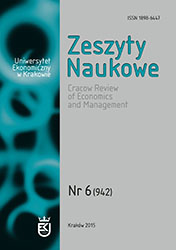Metodyczne aspekty pomiaru zjawiska urban sprawl
DOI:
https://doi.org/10.15678/ZNUEK.2015.0942.0603Słowa kluczowe:
urban sprawl, pomiar urban sprawlu, rozproszenie zabudowy, decentralizacja przestrzennaAbstrakt
Celem artykułu jest identyfikacja różnych przejawów urban sprawl oraz prezentacja sposobów pomiaru tego zjawiska. Metodą realizacji celu stał się przegląd literatury przedmiotu, zatem prezentowane opracowanie ma charakter teoretyczno-metodyczny. Wśród wiodących teoretycznych koncepcji pomiaru zjawiska dominują trzy podstawowe, które opierają się na wskaźnikach nawiązujących do różnych sposobów zabudowy terenu. Pierwsze podejście opiera się na takich wskaźnikach, jak: gęstość, rozproszenie, estetyczność, ekologia, dostępność. Drugie podejście korzysta z takich wskaźników, jak: stopa wzrostu, gęstość, geometria przestrzenna, dostępność, estetyczność. Trzecie podejście identyfikuje rodzaje sprawlu poprzez wskaźniki: gęstość, ciągłość, skupienie, grupowanie, centralizacja, nuklearność, zróżnicowanie użytkowania, bliskość. Ważną cechą trzeciego podejścia są doświadczenia w badaniach zagranicznych w implementacji tej metody. Ponadto jest to metoda prezentująca metodologię i charakterystykę wielu przejawów sprawlu, które mogą znaleźć zastosowanie w warunkach polskich.
Pobrania
Bibliografia
Bose S. [2004], Smart Growth in the State of Ohio: Conflicts and Constraints; An Analysis and Evaluation of the Evolution of Smart Growth in the Cleveland and Cincinnati Metropolitan Regions, The School of Planning of the College of Design, Architecture, Art and Planning, University of Cincinnati, Cincinnati.
Burchell R.W., Shad N.A., Listokin D., Phillips H., Downs A., Siskin S., Davis J.S., Moore T., Helton D., Gall M., ECONorthwest [1998], Costs of Sprawl–Revisited, National Academy Press, Washington, D.C.
Downs A. [1998], How America’s Cities Are Growing: The Big Picture, „Brookings Review”, vol. 16(4). DOI: https://doi.org/10.2307/20080808
Ewing R. [1997], Is Los Angeles-style Sprawl Desirable?, „Journal of the American Planning Association”, vol. 63(1). DOI: https://doi.org/10.1080/01944369708975728
Ewing R., Pendall R., Chen D. [2002], Measuring Sprawl and Its Impact, Smart Growth America, Washington D.C.
Frenkel A., Ashkenazi M. [2005], Measuring Urban Sprawl – How Can we Deal with It?, ERSA Conference Papers, European Regional Science Association.
Fulton W. [2001], Who Sprawls Most? How Growth Patterns Differ Across the U.S., The Brookings Institution, Washington D.C.
Galster G., Hanson R., Ratcliffe M.R., Wolman H., Coleman S., Freihage J. [2001], Wrestling Sprawl to the Ground: Defining and Measuring an Elusive Concept, „Housing Policy Debate”, vol. 12, nr 4, http://dx.doi.org/10.1080/10511482.2001.9521426. DOI: https://doi.org/10.1080/10511482.2001.9521426
Glaeser E.L., Kahn M.E. [2003], Sprawl and Urban Growth, „NBER Working Paper”, Series No. 9733, http://dx.doi.org/10.3386/w9733. DOI: https://doi.org/10.3386/w9733
Gordon P., Richardson H. [1997], Where is the Sprawl?, „Journal of the American Planning Association”, vol. 63(1).
Knapp G. [2002], Talking Smart in the United States, International Meeting for Multiple Intensive Land Use, Holland, Habiform.
Knaap G., Song Y., Ewing R., Clifton K. [2005], Seeing the Elephant: Multi-disciplinary Measure of Urban Sprawl, National Center for Smart Growth Research and Education, Urban Studies and Planning Program, University of Maryland.
Lisowski A., Grochowski M. [2009], Procesy suburbanizacji. Uwarunkowania, formy i konsekwencje, Instytut Demografii Społeczno-Ekonomicznej i Gospodarki Przestrzennej, Uniwersytet Warszawski, Warszawa.
Nelson A.C., Duncan J.B. [1995], Growth Management Principlesand Practices, American Planning Association, Chicago.
Neuman M. [2005], The Compact City Fallacy, „Journal of Planning Education and Research (JPER)”, vol. 25(1), http://dx.doi.org/10.1177/0739456x04270466. DOI: https://doi.org/10.1177/0739456X04270466
Pendall R. [1999], Do Land-Use Controls Cause Sprawl?, „Environment and Planning B”, vol. 26(4), http://dx.doi.org/10.1068/b260555. DOI: https://doi.org/10.1068/b260555
Sierra Club [1998], Sprawl: The Dark Side of the American Dream, San Francisco, CA.
Torrens P.M., Alberti M. [2000], Measuring Sprawl, Association of Collegiate Schools of Planning, Atlanta.
Wassmer R.W. [2002], An Economic Perspective on Urban Sprawl: With an Application to the American West and a Test of the Efficacy of Urban Growth Boundaries, California State University.
Wassmer R.W. [2005], Causes of Urban Sprawl (Decentralization) in the United States: Natural Evolution, Flight from Blight, and the Fiscalization of Land Use, Working Paper, Sacramento, CA.
Pobrania
Opublikowane
Numer
Dział
Licencja
Prawa autorskie (c) 2015 Zeszyty Naukowe Uniwersytetu Ekonomicznego w Krakowie

Utwór dostępny jest na licencji Creative Commons Uznanie autorstwa 4.0 Międzynarodowe.

